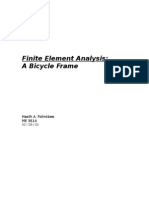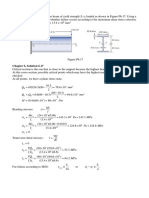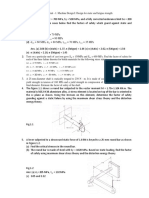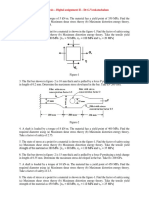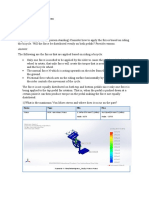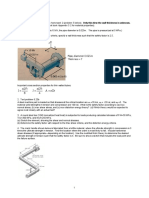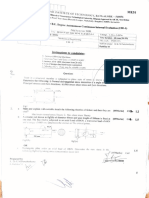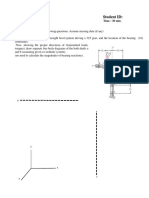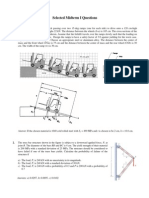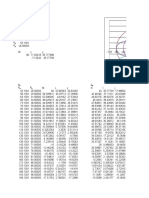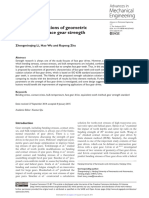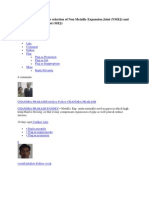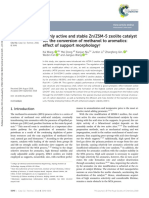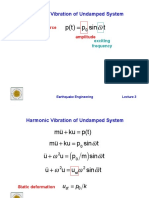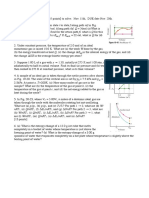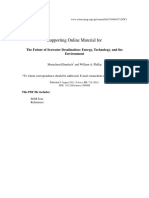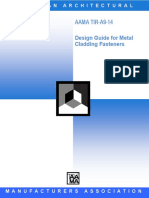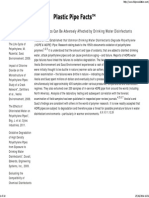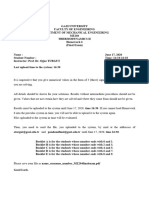MACHINE DESIGN - An Integrated Approach, 4th Ed.
Case Study 1C-1
CASE STUDY 1C
Bicycle Brake Lever Failure Analysis
Problem: Determine the factors of safety at critical points in the brake lever shown in
Figures 3-1 and 5-22.
Given: The stresses are known from the previous Case Study 1B. The material of the
brake lever is die-cast aluminum alloy ASTM G8A. The elongation to fracture
is 8% making it a marginally ductile material.
Yield strength S y 186 MPa
Tensile strength S ut 310 MPa
Bending moment at P MP 20.3 N m
4
Moment of inertia at P IP 2053 mm
Distance to outer fiber at P cP 7.150 mm
Shear load at P, Q V 267 N
2
Cross-section area at P, Q A 160.61 mm
Assumptions: The most likely failure points are the two holes where the pins insert and at the
root of the cantilever-beam lever handle.
Solution: See Figures 3-1 and 5-22 and Mathcad file CASE1C.
1. The bending stress at point P in Figure 5-22 at the root of the cantilever was found from equation 4.11b in
Case Study 1B and is
MP cP
σx σx 70.7 MPa (a)
IP
2. This is the only applied stress at this point so it is also the principal stress. The von Mises effective stress
σ' σx , and the principal stress is σ1 σ' in this case. The safety factor against yielding at point P is
then (from Eq. 5.8a),
Sy
Nyield Nyield 2.6 (b)
σ'
This design is safe at the average load but there is not a large margin to protect from overloads. Note that in
this simple stress situation, the distortion-energy theory gives identical results to the maximum shear theory
because the failure boundaries (ellipse and hexagon) are coincident at the point x = 1 , y = 0 in Figure 5-5.
3. Since this is a cast material with limited ductility, it would be interesting to also compute the modified-Mohr
safety factor against brittle fracture from equation 5.12a. It could be argued that the brake handle might still
be usable despite slight yielding having occured:
S ut
Nfracture Nfracture 4.4 (c)
σ1
Note that we have not accounted for stress concentrations at the root of the cantilever that could reduce this
fracture safety factor. Case Study 1D in Chapter 8 determines the stress concentration factor at point P using
Finite Element Analysis.
4. The transverse shear stress at point Q in Figure 5-22 was calculated from equation 4.15c as
4 V
τxy τxy 2.22 MPa (d)
3 A
This shear stress is also the maximum since no other stresses act at that point. The safety factor using the
distortion-energy theory for pure shear at point Q is
CASE1C.xmcd
�MACHINE DESIGN - An Integrated Approach, 4th Ed. Case Study 1C-2
0.577 S y
Nshear Nshear 48 (e)
τxy
Clearly, there is no danger of transverse-shear failure at point Q.
5. The compressive bearing stress in the hole at point A in Figure 5-22 is
Hole diameter d 8 mm
Single thickness at A tA 6.4 mm
Abearing d 2 tA
2
Total bearing area Abearing 102.4 mm
Load F12 1951 N
F12
Bearing stress σbearing σbearing 19.1 MPa (f)
Abearing
and this stress, acting alone, is also the principal and the von Mises stress. Assuming that the compressive
strength of this material is equal to its tensile strength (an even material), the safety factor against bearing
failure in the hole is
Sy
Nbearing Nbearing 9.8 (g)
σbearing
6. Tearout in this case requires that four 6.4-mm-thick sections fail in shear through the material between hole A an
the edge. (See also Figure 4-13.)
Hole A edge distance d edge 7.1 mm
Atearout d edge 4 tA
2
Tearout shear area Atearout 181.8 mm
F12
Shear stress τtearout τtearout 10.7 MPa (h)
Atearout
This is a pure shear case and the safety factor is found from
0.577 S y
Ntearout Ntearout 10.0 (i)
τtearout
7. The cable-end inserts in a blind hole that is half-slotted to allow the cable to pass through at assembly as
shown in Figure 5-22. This slot weakens the part and makes the section at R the most likely failure
location at this joint. The bending stress at the outer fiber is
Cable force Fc2 1914 N
Force at R FR 0.5 Fc2 FR 957 N
Distance from support
to force at R a 0.5 d a 4 mm
Depth of section h 5 mm
Width of section b 10 mm
Outer fiber distance c 0.5 h c 2.50 mm
Bending moment M FR a M 3828 N mm
3
b h 4
Moment of inertia I I 104.17 mm
12
CASE1C.xmcd
�MACHINE DESIGN - An Integrated Approach, 4th Ed. Case Study 1C-3
M c
Bending stress σx σx 91.9 MPa (j)
I
As the only applied stress at the outer fiber of this section, This is also the von Mises effective stress
σ' σx , and the principal stress is σ1 σ' . The bending safety factor at point R is
Sy
NQyield NQyield 2.0 (k)
σ'
8. The shear stress due to transverse loading at the neutral axis in the section at R is (Eq. 4.14b)
Shear load V 0.5 Fc2 V 957 N
2
Cross-section area A b h A 50 mm
Transverse shear stress 3 V
(rectangular section) τxy τxy 28.7 MPa (l)
2 A
This is the maximum shear stress at the neutral axis and the transverse-shear safety factor at point R is
τmax τxy S ys 0.577 S y
S ys
N N 3.7 (m)
τmax
It is interesting to note that the transverse-shear safety factor is only about twice the bending safety factor at
point R because the beam is so short. Compare this result with that at point P in equations b and e where the
bending and transverse shear safety factors differ by about a factor of 18 in the longer beam. See Figure 5-22.
9. The die-cast aluminum alloy chosen is one of the strongest available. If additional protection against
overloads (as from the bicycle falling) is desired, either a change of geometry to increase the section size
and/or reduce stress concentra- tions, or a change in material or manufacturing method could be made. A
forged- aluminum part would be stronger but would increase the cost. Thicker sections would increase the
weight slightly, but probably not prohibitively. Increasing the diameter of the handle around point P by
26% to 18 mm (with perhaps a more generous transition radius also) would double the safety factor there
since the section modulus is a function of d 3.
Even though some of the other safety factors may seem excessive, it may be impratical to reduce those
sections due to difficulties in casting thin sections. Other considerations may take into account the
appearance of a part intended for a consumer application such as a bicycle. If the dimensions do not look
"right" to the customer, it may give an undesired impression of cheapness. Sometimes it is better economics
to provide more thickness than is necessary for a suitable safety factor in order to provide a quality
appearance.
CASE1C.xmcd
